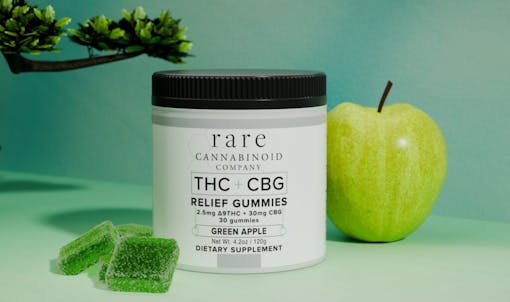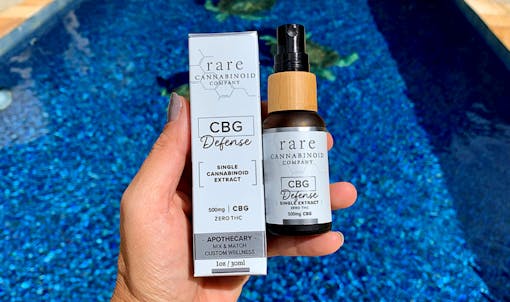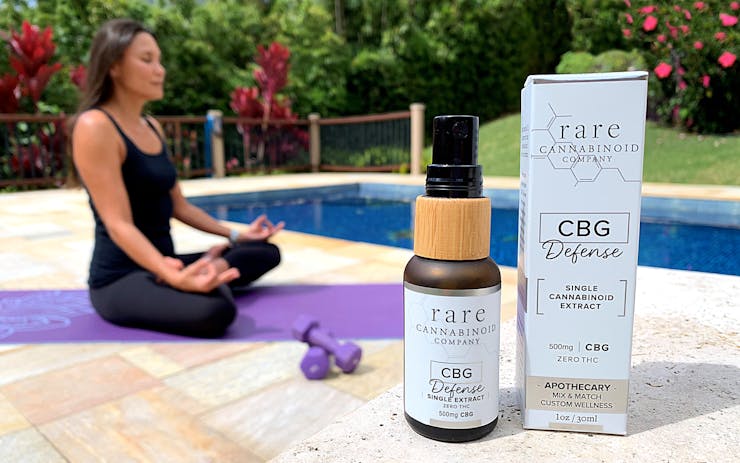Learn about CBG and how to add it to your wellness routine with Rare Cannabinoid Company tinctures and gummies.
Have you heard of CBG? Like CBD and THC, it’s a natural compound found in hemp and cannabis that offers a sense of calm and balance as well as some unique benefits. Read on to see studies on CBG for neuroprotection, cancer, and much, much more. You can experience CBG for yourself with Rare Cannabinoid Company’s pioneering CBG products that include tinctures, extra strength CBG gummies, and their new THC + CBG gummies.

CBG (cannabigerol) is often referred to as the “mother of all cannabinoids.” This is because CBGA, the acidic precursor to CBG, starts off in great abundance in hemp and cannabis plants. Almost all of the CBGA then transforms into CBDA or THCA, but a fraction of it becomes CBG. Because it occurs in such tiny quantities, usually less than 1% of the plant mass, it is known as a “rare” or “minor” cannabinoid. Other rare cannabinoids include: THCV (known for energy and appetite control), CBC (believed to fight depression), and CBN (often used for relaxation and restful sleep), CBDA (reportedly good for nausea), and CBDC (for socialability, memory, and decreased irritability).
While each cannabinoid offers unique effects–think of the difference between psychoactive THC versus non-intoxicating CBD–they all work with the human endocannabinoid system (ECS). All people–and animals with backbones–have an ECS. It’s a complex signaling system that regulates our bodily functions including appetite, anxiety, hormones, inflammation, pain, sleep, and immune system responses.
While reviewers often highlight CBG’s purported anti-anxiety effects, here we’ll look into the medical research on how CBG reduces inflammation and oxidative stress. This is important as both play huge roles in the development of cancer, neurodegenerative diseases, and associated pain. Of course, some of these studies also show how CBG may reduce stress and anxiety on a molecular level.
Although CBG naturally occurs in very small quantities, recent advances now make it possible to extract enough that one can buy purified CBG oils. This is because breeders have worked with hemp plant genetics to get the plants to produce more CBG. Extractors have also found the optimal time to extract CBG from hemp before it turns into CBD or THC.
Premium manufacturer Rare Cannabinoid Company uses this purified CBG from hemp to create CBG gummies (with and without THC) as well as 500mg CBG oil extracts and one-to-one CBG CBD blends that combine CBG with full spectrum Rare Hawaiian CBD. You can also find an apothecary line of reliable, third-party lab-tested oils and gummies of THCV, delta-9 THC, CBN, CBC, CBDA, CBGA, CBDV, terpenes, and CBD at Rare Cannabinoid Company.
“It’s an extremely exciting time to be able to offer these rare cannabinoids that offer so much hope, especially given the increasing amount of scientific research backing their efficacy,” said Jared Dalgamouni, founder and CEO of Rare Cannabinoid Company and Hawaiian Choice, Hawaii’s most-popular CBD company.
Can CBG reverse the aging process?

CBG’s key specialties include reducing inflammation and oxidative stress–which is defined as an imbalance of free radicals and antioxidants in the body. Oxidative stress is theorized to contribute to aging and has been suggested to lead to a vast number of diseases over time, including diabetes, cancer, inflammatory conditions, high blood pressure, heart disease, and neurodegenerative diseases.
Let’s take a look at CBG’s potential effects on neurodegenerative diseases. This is a big category as there are a whopping 600 neurologic disorders, with approximately 50 million Americans affected each year, according to the National Institute of Neurological Disorders and Stroke.
Some of the most-prevalent conditions are Alzheimer’s and other dementias, Parkinson’s and Huntington’s diseases, and multiple sclerosis. All neurodegenerative diseases are caused by the death of nerve cells in the brain and spinal cord, which leads to problems with movement and/or mental function.
As people in the developed world are living longer, an ever-increasing number are afflicted by these diseases. Neurodegeneration is now one of the major causes of disability and death. Sadly, there is no cure for these debilitating and progressive diseases. Thankfully, cannabinoids, and notably CBG, are showing great promise for potential therapies.
Neuroprotective effects of CBG

A recent study (May 2020) was conducted to compare the neuroprotective effects of CBD and CBG. The study’s authors said that “CBD’s effectiveness against neurological diseases has already been demonstrated,” so rodent experiments were carried out to quantify the differences between the two cannabinoids’ effects.
The scientists conducted multiple tests to mimic the effects of neurological diseases on rat tissue. Both CBD and CBG proved effective, but, when brain and spinal cord cells were exposed to hydrogen peroxide-induced toxicity, “CBG was more potent than CBD in blunting neurotransmitter depletion,” the study concluded. CBG was also more potent than CBD in counteracting toxicity in experiments done on rat cortexes.
Here are more links to specific studies on CBG and neurodegeneration:
For Parkinson’s disease, a 2018 study on mice found that CBG offers neuroprotection against damage caused by inflammation.
Also in 2018, a study was carried out on CBG’s effect on neuroinflammation (which is defined as an inflammatory response within the brain or spinal cord). This in vitro study found CBG to be effective at reducing neuronal death, inflammation, and oxidative stress. “In particular, CBG restored cell anti-oxidant defense.”
For Huntington’s disease, a 2015 study on mice found that “CBG was extremely active as neuroprotectant.” It improved motor deficits, preserved striatal neurons, and improved antioxidant defenses.”
“Our results open new research avenues for the use of CBG, alone or in combination with other phytocannabinoids or therapies, for the treatment of neurodegenerative diseases such as HD,” the study concluded.
For Multiple Sclerosis, a 2014 study in mice said that CBG “has been shown to alleviate symptoms in a viral model of multiple sclerosis.”
Interestingly, one of the few pharmaceutical drugs that contains cannabinoids was approved as a treatment for neuropathic pain in patients with multiple sclerosis. The drug, Sativex, contains a combination of THC and CBD.
Many people believe that cannabinoids work best in synergy with each other rather than taken alone. This is known as the entourage effect. It can be achieved by combining different cannabinoids with each other or with a full spectrum CBD or THC oil.
“We recommend that people look at the latest research on each cannabinoid to figure out their custom blend,” said Rare Cannabinoid Company’s Dalgamouni.

Is CBG a better pain reliever than THC?
Pain isn’t only a problem for multiple sclerosis patients. In fact, more than 20% of adults in the United States experience chronic or long-lasting pain.
A 2018 medicinal cannabis cohort analyzed patients with migraine, headache, arthritis, and chronic pain and found that 41.2 to 59.5% were able to substitute their prescription medications with cannabis.
The clinical study noted that THC (delta-9-THC) is one of the most researched cannabinoids for pain. Multiple studies were carried out in the 1990s and 2000s and THC was reported to be 20 times more anti-inflammatory than aspirin, twice as anti-inflammatory as hydrocortisone, and does not have the same risks of bleeding as non-steroidal anti-inflammatory drugs (NSAIDS).
However, THC is the main psychoactive component in cannabis which can make it difficult for patients who would like to drive, work, or generally stay sober during treatment. CBD and CBG, which are both non-intoxicating, may offer alternatives.
A 2017 study found that “CBG may hold great promise as an anti-oxidant agent” and “CBG has more potent analgesic (pain-relieving), anti-erythema (anti-inflammatory rash) and lipoxygenase (inflammation) blocking activity than THC.”
“Cannabinoids in the management of difficult to treat pain” references a study from the 1970s saying that “CBG exhibits GABA uptake inhibition to a greater extent than THC or CBD, suggesting possible utilization as a muscle relaxant in spasticity.” GABA uptake inhibitors can be used for a number of conditions including seizures, anxiety disorders (generalized anxiety disorder, social phobia, social anxiety disorder, panic disorder, etc.), insomnia, as muscle relaxants, and for chronic pain as analgesics.
While these studies, anecdotal reports, and online discussion boards show promise for CBG’s use as a pain reliever, robust long-term medical research in humans is needed.
CBG shows promise against MRSA, IBS, cancer
The list of CBG’s potential uses goes on. Studies show it could be useful for:
- “Superbug” MRSA, thanks to its antibacterial properties
- Glaucoma, by reducing intraocular eye pressure
- Bladder dysfunction, by inhibiting muscle contractions
- Inflammatory Bowel Disease (IBS), by reducing inflammation
Scientists are also looking into CBG’s effect on the ion channel TRPM8 and its potential to prevent and fight cancers.
TRPM8 stands for transient receptor potential melastatin member 8, also known as the “cold and menthol receptor” as it reacts to cold temperatures and cooling agents as well as warming capsaicin.
Irregular expression of the TRPM8 receptor is linked to the growth of tumors and prostate, breast, bladder, colorectal, pancreatic, and skin cancers.
CBG was shown to inhibit the growth of colorectal cancer (CRC) in mice through the TRPM8 channel in a 2014 experiment.
“In vivo, CBG inhibited the growth of xenograft tumours as well as chemically induced colon carcinogenesis. CBG hampers colon cancer progression in vivo and selectively inhibits the growth of CRC cells,” the study said.
It concluded that “CBG should be considered translationally in CRC prevention and cure.”
Also, in a study on mouse skin melanoma cells, “cannabigerol displayed significant antitumor activity.”
Other studies show that taking a combination of cannabinoids together can offer the greatest benefits.
A 2018 breast cancer study found that taking CBG, THCA, and THC together was more effective than THC alone in tests on both cell cultures and on living animals.
In 2020, Israeli researchers found that CBG and CBC (cannabichromene) exhibit anti-tumor properties as tested on human gastrointestinal cancer cells.
Where to buy CBG and how to take it
As the science behind the cannabinoids we take expands, it becomes ever more important to know exactly what’s in your hemp or cannabis product. Most cannabis flowers and full spectrum CBD or THC oils will contain trace amounts of CBG. But, to receive a more concentrated dose of CBG or other specific rare cannabinoids, it is advisable to turn to specially prepared products.
Rare Cannabinoid Company offers an “Apothecary line” of CBG, THCV, CBC, CBN, CBDV, and CBDA as single extracts. They can be combined with each other or the brand’s full spectrum Rare Hawaiian CBD oil for the entourage effect. Each of the single extracts contain 500mg rare cannabinoid in flavorless organic MCT coconut oil. CBD comes in 1000mg and 3000mg bottles.
“We offer a mix and match concept, so that our customers can fully control their cannabinoid intake,” said founder and CEO Dalgamouni.
“We have a lot of people report success with THCV in the morning and CBN at night or CBC for mood and CBG for aches and pains after they exercise,” he said. “There are so many uses and options.”
Gummies and ready blends
The company also offers a wide selection of gummies and oils that combine pure rare cannabinoids with CBD. Some of the gummies also have noticeable levels of hemp-derived Delta-9-THC.
For example, extra-strength CBG gummies each contain 30mg CBG and 10mg CBD. Full spectrum THC + CBG gummies contain the same amounts CBG and CBD and also have 2.5mg delta-9-THC per gummy. The low level of THC can work synergistically with the other cannabinoids to heighten pain-relieving effects.
If one isn’t sure if they’d like to buy THC gummies or stick to THC-free products, they can try sample packets of each using a coupon code they receive after taking the company’s cannabinoid finder quiz. This handy tool helps people find the best cannabinoids for their needs.
“Ready Blends” are tinctures that contain equal parts of rare cannabinoids and full spectrum Rare Hawaiian CBD. The blends contain organic MCT coconut oil and are lightly flavored with food-grade organic wild orange and Italian lemon oils. They offer the entourage effect and do not need to be combined with other hemp products for that benefit.
Lab tested and affordable
Rare Cannabinoid Company’s CBG oils–the single extract and the blend–each cost $49. CBG gummies cost $59 and THC+CBG Gummies are $79.
For full peace of mind, you can see independent lab test results for each batch of every product on their website.
You can also learn more about how and why the founders of Hawaiian Choice decided to create Rare Cannabinoid Company in our article: “Looking for THCV, CBN, CBG or CBC? Rare Cannabinoid Company has you covered.”

For full peace of mind, you can see independent lab test results for each batch of every product on their website.
You can also learn more about how and why the founders of Hawaiian Choice decided to create Rare Cannabinoid Company in our article: “Looking for THCV, CBN, CBG or CBC? Rare Cannabinoid Company has you covered.”
Can THCV really curb the munchies?
Rare Cannabinoid Company was also the first in the world to create a THCV oil tincture. You can learn more about their THCV oil in our article: “Can THCV really curb the munchies?”
Spoiler alert: Yes! THCV may promote weight loss, according to the latest scientific studies.
We look forward to seeing more medical research on each cannabinoid and sharing it with you in the future.






